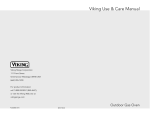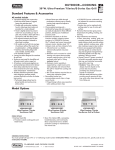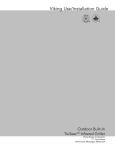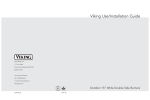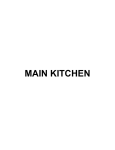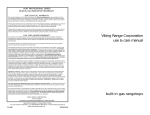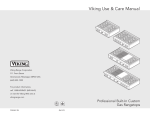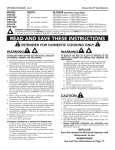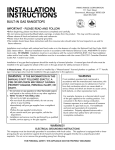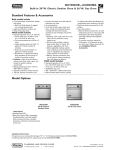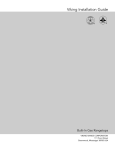Download Viking VGSB152T Installation guide
Transcript
Viking Installation Guide Viking Range Corporation 111 Front Street Greenwood, Mississippi 38930 USA (662) 455-1200 For product information, call 1-888-VIKING1 (845-4641) or visit the Viking Web site at vikingrange.com F20056I EN VGSB T-Series Outdoor 15” Wide Double Side Burners & VGRT 24” Wide Outdoor Rangetop (033108J) BASIC SPECIFICATIONS IMPORTANT: PLEASE READ AND FOLLOW 1. 2. 3. 4. Before beginning, please read these instructions completely and carefully. Do not remove permanently affixed labels, warnings, or plates from product. This may void the warranty Please observe all local and national codes and ordinances. The installer should leave these instructions with the consumer who should retain for local inspector’s use and for future reference Description Overall Width Overall Depth WARNING If you smell gas: 1. Shut off gas to the appliance. 2. Extinguish any open flame. 3. Open lid. 4. If odor continues, immediately call your gas supplier or your fire department. If not installed, operated and maintained in accordance with the manufacturer’s instructions, this product could expose you to substances in fuel or fuel combustion which can cause death or serious illness and which are known to cause cancer, birth defects or other reproductive harm. For example, benzene is a chemical which is part of the gas supplied to the cooking product. It is consumed in the flame during combustion. However, exposure to a small amount of benzene is possible if a gas leak occurs. Formaldehyde and soot are byproducts of incomplete combustion. Properly adjusted burners with a bluish rather than yellow flame minimize incomplete combustion. FOR YOUR SAFETY 1. Do not store or use gasoline or other flammable vapors and liquids in the vicinity of this or any other appliance. 2. Any LP cylinder not connected for use shall not be stored in the vicinity of this or any other appliance. VGRT244T 15-5/16” (38.9 cm) 26 1/4” (66.7 cm) To end of landing ledge 31-9/16” (80.2 cm) To end of knobs 32-5/8” (82.9 cm) Overall Height To cooking surface 10 1/2” (26.3 cm) Cutout Width 14 ” (35.6 cm) 24 3/4” (62.9 cm) Cutout Depth 27-1/2” (69.9 cm) 27-1/2” (69.9 cm) Cutout Height 10-1/4” (26.0 cm) 10-1/4” (26.0 cm) Gas Natural: standard residential 1/2” (1.3 cm) ID gas service line. Requirements LP/Propane: equipped with high capacity hose/regulator assembly for connection to standard 5gal, 20 lb. LP/Propane gas cylinder with Type 1, QCC-1 connection or standard residential 1/2” (1.3 cm) ID gas service line. Side Burner (2) - 15,000 BTU Nat./13,500 BTU LP (4) - 15,000 BTU Nat./13,500 BTU LP Rating (4.4 kW Nat./4.0 kW LP) (4.4 kW Nat./4.0 kW LP) Approximate Shipping Wt. 80 lbs. (36.3 kg) 160 lbs (72.0 kg) Installation must conform with local codes or in the absence of codes, the National Fuel Gas Code, ANSI Z223.1. In Canada: Installation must be in accordance with the current CAN/CGA-B149.1, Natural Gas Installation Code or CAN/CGA-B149.2, Propane Installation Code and/or local codes. FOR YOUR SAFETY VGSB152T GENERAL INFORMATION 1. WARNING: This outdoor gas side burner is not intended to be installed in or on recreational vehicles and/or boats. 2. WARNING: Keep electrical supply cord and the fuel supply hose away from heated surfaces. 3. Keep area clear and free from combustible materials, gasoline, and other flammable vapors. 4. When the outdoor gas side burner is not in use, the gas supply must be turned off at the LP gas supply cylinder. 5. The pressure regulator and hose assembly supplied with the unit must be used. Replacement pressure regulators and hose assemblies must be those specified by the manufacturer. 6. Finding a leak is not a “do-it-yourself” procedure. Some leaks can only be found with the burner control in the on position and this must be done by a qualified technician. 7. The LP supply cylinder to be used must be constructed and marked in accordance with the specifications for LP-gas cylinders of the U.S. Department of Transportation (DOT) or the National Standard of Canada, CAN/CSA-B339, Cylinders, Spheres, and Tubes for the Transportation of Dangerous Goods. 8. Gas Manifold Pressure Natural gas - 4.0” W.C.P. LP/Propane - 10.0” W.C.P. 9. If the following instructions are not followed exactly, a fire causing death or serious injury may occur: -Do not store a spare LP gas cylinder under or near this appliance. -Never fill the cylinder beyond 80 percent full. GAS CONNECTION Verify the type of gas supply to be used, either natural or LP, and make sure the marking on the rating plate agrees with that of the supply. Never connect an unregulated gas line to the appliance. An installer supplied gas shut-off valve must be installed in an easily accessible location. All installer supplied parts must conform to local codes, or in the absence of local codes, with the National electrical Code, ANSI/NFPA 70 and the National Fuel Code, ANSI Z223.1. In Canada: Installation must be in accordance with the current CAN/CGA-B149.1, Natural Gas Installation Code or CAN/CGA-B149.2, Propane Installation Code and/or local codes. All pipe sealants must be an approved type and resistant to the actions of LP gas. Never use pipe sealant on flare fittings. All gas connections should be made by a competent technician and in accordance with local codes and or ordinances. In the absence of codes, the installation must comply with the National Fuel Gas Code ANSI Z223.1. The gas side burner and its individual shut-off valve must be disconnected from the gas supply piping system during any pressure testing of that system at test pressures in excess of 1/2 PSIG (3.5 kPa). The unit must be isolated from the gas supply piping system by closing its individual manual shut-off valve during any pressure testing of that sysptem at test pressures equal to or les than 1/2 psi (3.5 kPa). Built-in installations must be plumbed using a fixed/hard line if the unit is going to be operated at a distance exceeding 3 feet (0.91 meters) from the fuel supply per ANSI Z21.24. 2 3 NATURAL FIXED PIPING CONNECTION LP/PROPANE FIXED PIPING CONNECTION Connection: Operating Pressure: Supply Pressure: Connection: Operating Pressure: Supply Pressure: Standard Residential 1/2” ID gas service line - 1/2” NPT male with 1/2” flare adapter. 4.0” W.C.P. Nat. 6” to 14” W.C.P. Nat. If in excess of 14” W.C.P., a step-down regulator is required. Standard Residential 1/2” ID gas service line - 1/2” NPT male with 3/8” flare adapter. 10.0” W.C.P. Nat. 11” to 14” W.C.P. Nat. If in excess of 14” W.C.P., a step-down regulator is required. Check with your local gas utility company or with local codes for instructions on installing gas supply lines. Be sure to check on type and size of run and how deep to bury the lines. If the gas line is too small, the grill will not function properly. Check with your local gas utility company or with local codes for instructions on installing gas supply lines. Be sure to check on type and size of run and how deep to bury the lines. If the gas line is too small, the grill will not function properly. To connect the supplied regulator assembly to the incoming flexible gas line, attach with a 1/2” (1.3 cm) female flare adaptor to the 1/2” (1.3 cm) male flare adaptor on the regulator assembly. Ensure that the regulator arrow points in the direction of the gas flow towards the unit and away from the supply. Attach the regulator assembly to the grill unit by pulling back the female coupler sleeve towards the regulator. Insert the coupler into themale coupler fitting on the grill until the sleeve snaps forward securing the connection. DO NOT forget to place the installer supplied gas valve in an accessible location. To connect the supplied regulator assembly to the incoming flexible gas line, attach with a 3/8” female flare adaptor to the 3/8” male flare adaptor to the regulator assembly. Ensure that the regulator arrow points in the direction of the gas flow towards the unit and away from the supply. Attach the regulator assembly to the grill unit with the 3/8” flemale flare adapter on the regulator assembly to the 3/8” male flare adaptor on the grill. DO NOT forget to place the installer supplied gas valve in an accessible location. NOTE: If using a Viking GSH12 flexible hose, remove the 3/8” flare adapter and attach hose to the the 1/2” (1.3 cm) male flare on the regulator assembly. 3/8” female flare adaptor Female coupler sleeve Regulator 1/2” male flare adaptor Regulator Assembly Regulator Male coupler fitting 3/8” Male flare adaptor 3/8” male flare adaptor Installer supplied flexible gas line with 1/2” female flare adaptor or Viking GHS12 4 Regulator Assembly Installer supplied flexible gas line with 3/8” female flare adaptor or Viking GHS12 5 LP/Propane Tank Connection LEAK TESTING Outdoor side burners orificed for use with LP/Propane gas come equipped with a high capacity hose/regulator assembly for connection to a standard 20 lb. LP/Propane cylinder equipped with a Type 1, QCC-1 connector. (See LP/Propane tank requirements on page 6). Built-in installations must be plumbed using a fixed/hard line if the unit is going to be operated at a distance exceeding 3 feet (0.91 meters) from the fuel supply per ANSI Z21.24. Also, in a built-in construction where an LP/Propane tank is going to be used, there MUST be some type of support (braces, cut-out, etc.) to prevent tank from moving within the installation. The support must also allow the LP/Propane tank to withstand a horizontal tipping force equal to the weight of the tank without tipping over. The tank can not tip over or deflect more than 1.00 inch when a 38 lb. horizontal force is applied to a 20 lb. LP/Propane tank. Connection: 1/2” (1.3 cm) NPT male with a 3/8” (.95) flare adapter Operating Pressure: 10.0” W.C.P. To connect to LP/Propane regulator/hose assembly: Although the flow of gas is stopped when the quick disconnect system is disconnected as part of its safety feature, you should always turn the LP/Propane tank main valve “OFF” after each use and during transport of the tank or unit. First connect the regulator to the grill unit by screwing the 3/8” flare coupling ot the 3/8” flare adaptor. Connect to the tank valve by screwing the Type 1, QCC-1 connector to the LP/Propane tank. Open the tank valve and check the connection between the regulator and the Type 1, QCC-1 fitting for leaks with a soapy water solution. If bubbles appear, tighten the connection. Repeat until all leaks have been stopped. ALWAYS CHECK FOR LEAKS AFTER EVERY LP/PROPANE TANK CHANGE. Although all gas connections on the grill are leak tested at the factory prior to shipment, a complete gas tightness check must be performed at the installation due to possible mishandling in shipment or excessive pressure unknowingly being applied to the unit. Periodically check the whole system for leaks, or immediately check if the smell of gas is detected. 1. Do not smoke while leak testing. Extinguish all flames. 2. Never leak test with an open flame. 3. Make a soap solution of one part liquid detergent and one part water. You will need a spray bottle, brush or towel to apply the solution to the fittings. For LP/Propane units, check with a full cylinder. 4. Check that all control knobs are in the “OFF” position. 5. Turn cylinder valve knob counter clockwise one turn to open. 6. Blowing bubbles in the soap solution indicates that a leak is present. 7. Stop a leak by tightening the loose joint or by replacing the faulty part with a replacement part recommended by the manufacturer. Do not attempt to repair the cylinder valve if it should become damaged. The cylinder must be replaced. 8. If you are unable to stop a leak, shut off the gas supply at the cylinder valve. Remove the cylinder from the grill. Call an authorized gas appliance service technician or LP/Propane gas dealer. Do not use the grill until the leak is corrected. 9. After checking for leaks, push in and turn any control knob to release the pressure in the hose and manifold. Turn off the control knob. Any joint sealant used must be an approved type and be resistive to the actions of LP/Propane gas. CAUTION 3/8” flare adaptor Before placing into operation, always check for gas leaks with a soapy water solution. DO NOT USE AN OPEN FLAME TO CHECK FOR LEAKS! 3/8” flare coupling Tank Type 1, QCC-1 connector LP/Propane Tank Requirements A dented or rusty LP/Propane tank may be hazardous and should be checked by your tank supplier. Never use a cylinder with a damaged valve. All tanks should be equipped with an OPD (overfilling protection device). This is a DOT requirement for all tanks purchased after October 1, 1998 and will ensure that the tank is not overfilled. The LP/Propane tank should be a standard 5-gal, 20 lb. gas cylinder tank approximately 12” in diameter and 18” high which must be constructed and marked in accordance with the Specifications for LP/Propane Gas Cylinders of the U.S. Department of Transportation (D.O.T.) or the National Standard of Canada, CAN/CSA-B339, Cylinders, Spheres and Tubes for Transportation of Dangerous Goods; and Commission. The cylinder connection device must be compatible with the Type 1, QCC-1 connector on the outdoor cooking appliance. The cylinder must be provided with a shut-off valve terminating in an LP/Propane gas supply cylinder valve outlet specified. The cylinder supply system must be arranged for vapor withdrawal and provided with a listed overfilling prevention device. If the appliance is stored indoors the cylinder must be disconnected and removed from the appliance. Cylinders must be stored outdoors in a well-vented area out of the reach of children. 6 LEAK TEST POINTS Tank 7 INSTALLATION PROCEDURES FOR BUILT-IN INSTALLATION Built-In Clearance Dimensions 1. A minimum of 6” (15.2 cm) from the sides must be maintained from the side burners above the cooking surface to adjacent vertical combustible construction. The unit is not to be located under overhead unprotected combustible construction. 2. It is desirable to allow at least 6” side clearance to non-combustible construction above the cooking surface for counter space. 3. When determining a suitable location for the unit, take into account concerns such as exposure to wind, proximity to traffic paths and keeping gas supply lines as short as possible. Locate only in a well-ventilated area. Never locate in a building, garage, breezeway, shed or other such enclosed areas. 4. In a built-in construction where an LP/Propane tank is going to be used, there MUST be some type of support (braces, cutout, etc.) to prevent tank from moving within the installation. The support must also allow the LP/Propane tank to withstand a horizontal tipping force equal to the weight of the tank without tipping over. The tank can not tip over or deflect more than 1.00 inch when a 38 lb. horizontal force is applied to a 20 lb. LP/Propane tank. Front View VGSB152T Min. 6” (15.2 cm) to combustible surfaces 15 5/16” (38.9 cm) IMPORTANT: Gas fittings, regulator, and installer supplied shut-off valve must be easily accessible. Front View VGRT244T A Min. 6” (15.2 cm) to combustible surfaces 26 1/4” (66.7 cm) A VGSB151T VGRT244T 8 14” (35.6 cm) 24 3/4” (62.9 cm) 9 Built-In Clearance Dimensions VENTILATION FOR BUILT-IN INSTALLATIONS Side View Not less than 5.00 inches from inside bottom of countertop. 5.00 inch maximum Vents 5.00 inch maximum 1.00 inch maximum No more than 5.00 inches above the floor of the installation. Not less than 1.00 inch from inside floor of installation. 1. At least one ventilation opening shall be provided on the exposed exterior side of the enclosure located within 5 inches (127 mm) of the top of the enclosure and unobstructed. The opening(s) shall have a total free area of not less than 1 in2/lb (14.2 cm2/kg) of stored fuel capacity. 2. At least one ventilation opening shall be provided on the exposed, exterior side of the enclosure 1 inch (25.4 mm) or less from the floor level and shall have a total free area of not less than 1/2 in2/lb (7.1 cm2/kg) of stored fuel capacity. The upper edge shall be no more than 5 inches (127 mm) above the floor level. 3. Every opening shall have a minimum dimension so as to permit the entrance of a 1/8 inch (3.2 mm) rod. 10 11 BURNER ADJUSTMENT PERFORMANCE CHECKLIST Each burner is tested and adjusted at the factory prior to shipment; however, variations in the local gas supply may make it necessary to adjust the burners. The flames of the burners should be visually checked and compared with flame height illustration. Flames should be blue and stable with no yellow tips, excessive noise or lifting. If any of these conditions exist, check if the air shutter or burner ports are blocked by dirt, debris, spider webs, etc. With a proper flame height, adjust the air shutter to obtain a blue flame with no yellow tipping that sits on the burner at the burner ports. The air shutter is locked in place by a set screw which must be loosened prior to lighting the burner for adjustments. To access the air shutter on the side burners, remove the grates, burner bowls, and grate support. With a screw driver, loosen the lock-screw on the face of the air shutter. Light the burner and adjust according to the directions below. 1. If the flame is yellow, turn the air shutter counter clockwise to allow more air to the burner. 2. If the flame is noisy and lifting away from the burner, turn the air shutter clockwise to reduce the amount of air to the burner. Once adjusted, turn the burner off, tighten the set screw on the air shutter, replace the valve panel for the grill burners and the grate support, burner bowls, and grates for the side burners. A qualified installer should carry out the following checks: To ensure proper installation of the side burners, slide opening in air shutters over the orifice located in the front of the unit. Air Shutters 1. 2. 3. 4. 5. 6. 7. All internal packaging removed. Specified clearances maintained to combustible materials. Pressure regulator connected and set. Manual shut-off valve installed and accessible. Check air shutter adjustment - sharp blue flame, no yellow tipping. Check for gas leaks (odors) at all gas connections. Each burner lights satisfactory, individually or with adjacent burners lit. Any adjustments necessary that are the result of the installer not following instructions will be responsibility of the installer, dealer or the end user of the product. FINAL PREPARATION 1. Some stainless steel parts may have a plastic protective wrap which must be peeled off. The interior should be washed thoroughly with hot, soapy water to remove film residues and any dust or debris before being used, then rinsed and wiped dry. Solutions stronger than soap and water are rarely needed. 2. All stainless steel body parts should be wiped with hot, soapy water and with a liquid cleaner designed for this material. If buildup occurs, do not use steel wool, abrasive cloths, cleansers, or powders! If it is necessary to scrape stainless steel to remove encrusted materials, soak with hot, wet cloths to loosen the material, then use a wool or nylon scraper. Do not use a metal knife, spatula, or any other material tool to scrape stainless steel! Scratches are almost impossible to remove. REPLACEMENT PARTS Only authorized replacement parts may be used in performing service on the side burners. Do not repair or replace any part of the outdoor grill unless specifically recommended in the manual. All other servicing should be referred to a qualified technician. Orifice 1½” (3.8 cm) FLAME HEIGHT 3/8” (.95 cm) 12 13 14 15








